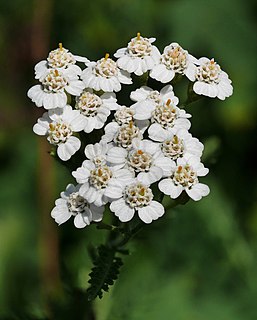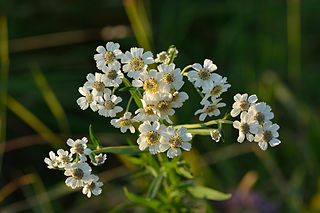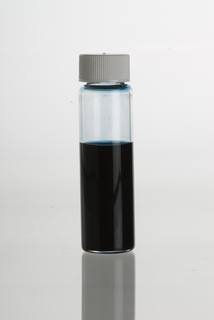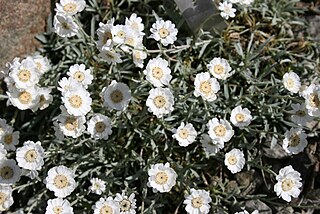
Achillea millefolium, commonly known as yarrow or common yarrow, is a flowering plant in the family Asteraceae. It is native to temperate regions of the Northern Hemisphere in Asia, Europe, and North America. It has been introduced as a feed for livestock in New Zealand and Australia, where it is a common weed of both wet and dry areas, such as roadsides, meadows, fields and coastal places.

Achillea is a group of flowering plants in the family Asteraceae, known colloquially as yarrows. They were described as a genus by Linnaeus in 1753. The genus was named after the Greek mythological character Achilles. According to legend, Achilles' soldiers used yarrow to treat their wounds, hence some of its common names such as allheal and bloodwort.

Achillea ptarmica is a European species of herbaceous perennial flowering plant in the genus Achillea of the daisy family Asteraceae. Common names include the sneezewort, sneezeweed, bastard pellitory, European pellitory, fair-maid-of-France, goose tongue, sneezewort yarrow, wild pellitory, and white tansy. It is widespread across most of Europe and naturalized in scattered places in North America. It is native to Europe and western Asia.

Yarrow essential oil is a volatile oil including the chemical proazulene. The dark blue essential oil is extracted by steam distillation of the flowers of yarrow.
Milfoil is a common name for several plants and may refer to:

Achillea filipendulina, the yarrow, fernleaf yarrow, milfoil, or nosebleed, is an Asian species of flowering plant in the sunflower family, native to central and southwestern Asia. It is also naturalized in parts of Europe and North America.

Achillea nobilis, the noble yarrow, is a flowering plant in the sunflower family. It is native to Eurasia, widespread across most of Europe and also present in Turkey, the Caucasus, and Central Asia. It is reportedly present in Xinjiang Province in western China, but this is based on a single herbarium specimen collected in the 19th century. The species is widely cultivated and has become naturalized outside of its range in North America and other parts of the world.

Achillea aegyptiaca, the Egyptian yarrow, is an ornamental plant in the aster family native to Greece.

Achillea ageratifolia, the Balkan yarrow or Greek yarrow, is a species of flowering plant in the daisy family Asteraceae, native to Greece and Bulgaria. Growing to 20 cm (7.9 in) tall and broad, it is a compact herbaceous perennial. It is a highly variable species, with three recognized subspecies. They have erect, simple, somewhat woody based stems. The narrow grey-green foliage resembles that of a related genus Ageratum, hence the Latin specific epithet ageratifolia. The solitary, daisy-like composite flower heads are white with yellow centres and about 2–3 cm across. They appear May–July in the northern hemisphere.

Gillmeria pallidactyla is a moth of the family Pterophoridae first described by the English entomologist, Adrian Hardy Haworth in 1811. It has a Holarctic distribution and is widespread throughout North America and the Palearctic.

Achillea ageratum, also known as sweet yarrow, sweet-Nancy, English mace or sweet maudlin, is a flowering plant in the sunflower family, native to Europe, and Morocco. In the United States the plant is cultivated in the state of New York for its pleasant fragrance and sparingly naturalized in a few places outside its native range.

Achillea atrata, commonly called black yarrow or dark stemmed sneezewort, is European species of herbaceous perennial flowering plant native to the Alpine regions of Switzerland, France, Italy, Germany, Austria, and Slovenia.

Achillea clavennae, the silvery yarrow, is a herbaceous perennial flowering plant in the sunflower family. The species name (clavennae) honors the Italian botanist N. Clavena.

Achillea ligustica, the southern yarrow or Ligurian yarrow, is a flowering plant in the sunflower family. It is native to southern Europe and sparingly naturalized in scattered locations in North America.

Achillea alpina, commonly known as alpine yarrow, Chinese yarrow or Siberian yarrow, is an Asian and North American species of plant in the sunflower family. It is native to Siberia, the Russian Far East, China, Mongolia, Korea, Japan, Nepal, Canada, the northern United States.

Achillea tomentosa, commonly known as woolly yarrow, is a flowering plant in the family Asteraceae. It is sometimes kept as a garden plant, and occasionally naturalizes outside its original range of dry lowland habitats of southern Europe and (possibly) western Asia. It is a recipient of the RHS's Award of Garden Merit.

Achillea cretica, Cretan yarrow, is a species of flowering plant in the family Asteraceae, native to Greece, the East Aegean Islands, Crete, Turkey, and Cyprus. It is typically found in calcareous rocky areas such as cliffs, gorges, scree fields, and even ancient ruins, and is somewhat tolerant of salty conditions.

Achillea collina is a species of perennial herb in the family Asteraceae. They have simple, broad leaves and can grow up to 52 cm tall.

















